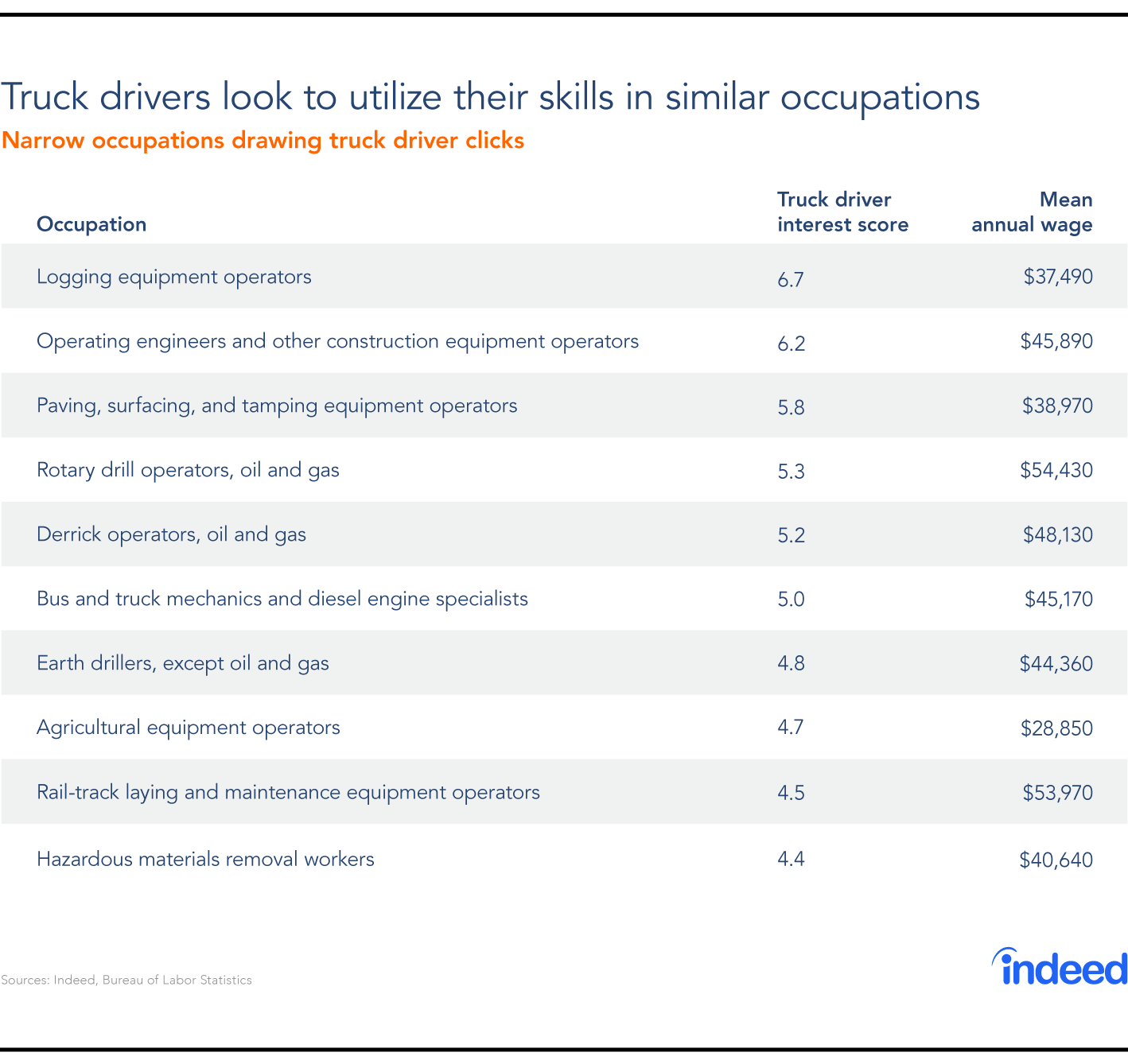Rapid advances in artificial intelligence have made automation and its potential to displace workers throughout the labor market one of the biggest unknowns of our economic future. Self-driving vehicles are one application of this technology that has sparked enormous interest. Driverless taxis are probably the most discussed example–and the dream of introverted taxi passengers everywhere. But the first large advances in this technology may be in the trucking industry, where long stretches of highway are much more forgiving of self-driving vehicles.
This raises big questions for truck drivers: If they end up at the forefront of a wave of automation that forever alters the landscape of the trucking industry, what occupations could they move to? And more importantly, how would their earnings be affected?
An analysis of Indeed job search and resume data finds that truck drivers currently explore many options outside their current occupation, typically ones that require similar skillsets. However, these alternative jobs generally offer paychecks significantly below the average $43,590 drivers earn behind the wheel.
Just how much automation could replace truck drivers is unclear. A scenario in which drivers are completely replaced by self-driving trucks picking up a load, navigating through congested city traffic and across America’s highway system is difficult for most to imagine and could be decades or more away. However, technology that could assist drivers on long stretches of highway, allowing fewer drivers to cover more road, is currently in development, as exemplified by the world’s first autonomous truck delivery in 2016.
The Bureau of Labor Statistics estimates there are about 1.7 million heavy and tractor-trailer truck drivers in the US. It’s not likely to happen overnight, but automation in the industry could eventually force some of them to find work elsewhere, and could have a “potentially profound impact on labor demand,” according to a new report by the U.S. Department of Commerce Even if only a small percentage of trucking jobs are lost to automation, the impact on earnings and the labor market could be substantial.
What other jobs are attractive to truck drivers?
By focusing on truck driver job search activity, we identified the alternative occupations that most interest them. When searching for new opportunities, about half the clicks from truck drivers are for job postings outside the Transportation category. This figure may seem high, but it’s not unexpected. Job seekers often look outside their occupations. We might expect a particularly high rate for truckers since stagnant wages, long hours and extended stretches of time away from home contribute to a consistently elevated turnover rate in the trucking industry.
We compare the share of truck driver clicks to jobs outside the Transportation category with that occupation’s share of clicks from all job seekers, yielding a ratio that shows how much more likely a truck driver is to click on that occupation. For example, truck drivers are nearly 14 times more likely than other job seekers to click on Pile-Driver Operator postings.

Two factors are immediately apparent in the list of occupations that interest truck drivers. First, the requirements for these roles are similar to those for truck drivers. They do not typically require education or certification beyond high school. Moreover, the predominance of operator positions reflects truck drivers’ preference for jobs for which their skills are transferable—particularly operating heavy machinery in construction.
Second, the oil and gas industry is also a common destination for truck drivers. Two of the six top roles are in the oil and gas industry, which, similar to the trucking industry, typically offers high pay relative to education and skill requirements.
How much do alternative occupations pay?
Automation’s threat to trucking may have a particularly strong impact on the labor market because truck driving is one of the few remaining jobs that pay middle-class wages without requiring a college degree or years of training. In May 2016, the average annual wage for heavy- and tractor-trailer truck drivers was $43,590, significantly higher than the $35,615 average of those with no more than a high school education or equivalent.
If many of these well-paying driving jobs are eventually lost to automation, the opportunities for truck drivers to find other jobs with similar pay are limited. The average annual wage of the ten roles getting the most interest from truck drivers on Indeed is $45,233, slightly higher than that of truck drivers. However, this probably overstates the earnings potential of former drivers. Understandably, truck drivers looking for jobs outside the industry focus their searches on the most lucrative roles possible. But since openings for these jobs are limited, it’s not guaranteed that most truckers will end up in these roles.
Instead, it’s more likely truckers will end up in other jobs available to those with only a high-school degree. So it’s more realistic that their earnings prospects will be around the average pay of high school graduates—meaning displaced truck drivers are more likely to end up in jobs that pay on average about $8,000 less a year than driving jobs.
Self-driving technology is still in early stages of development and faces a steep hill of legal and regulatory issues that could slow how quickly automated trucks hit the road. Nonetheless, the threat of automation hangs on the horizon for truck drivers, as it does for many workers across the labor market. The opportunities for workers automated out of jobs to move into new roles will not only affect their own economic wellbeing, but also the health of the labor market as a whole.
Methodology
We classify job seekers as truck drivers if their Indeed resumes feature job titles distinct to trucking, such as truck driver, owner operator driver and tractor-trailer driver. The occupations by which we classify clicks to jobs are the Standard Occupational Classifications as defined by federal statistical agencies, which break down the labor market into 840 specific occupations.
The truck driver interest ratio is the volume of clicks to an occupation as a share of all clicks by all job seekers compared with those of job seekers with truck driving experience on their resumes. To measure how likely a truck driver is to click on an occupation compared with all job seekers, the share of clicks for truck drivers is divided by that of all job seekers.
Wage data are from two sources. Occupational wages are the mean annual wage from the Bureau of Labor Statistics Occupational Employment Statistics, May 2016. Earnings for those with a high school education are from the US Census Bureau Current Population Survey 2016 Annual Social and Economic Supplement, which provides 2015 data.






